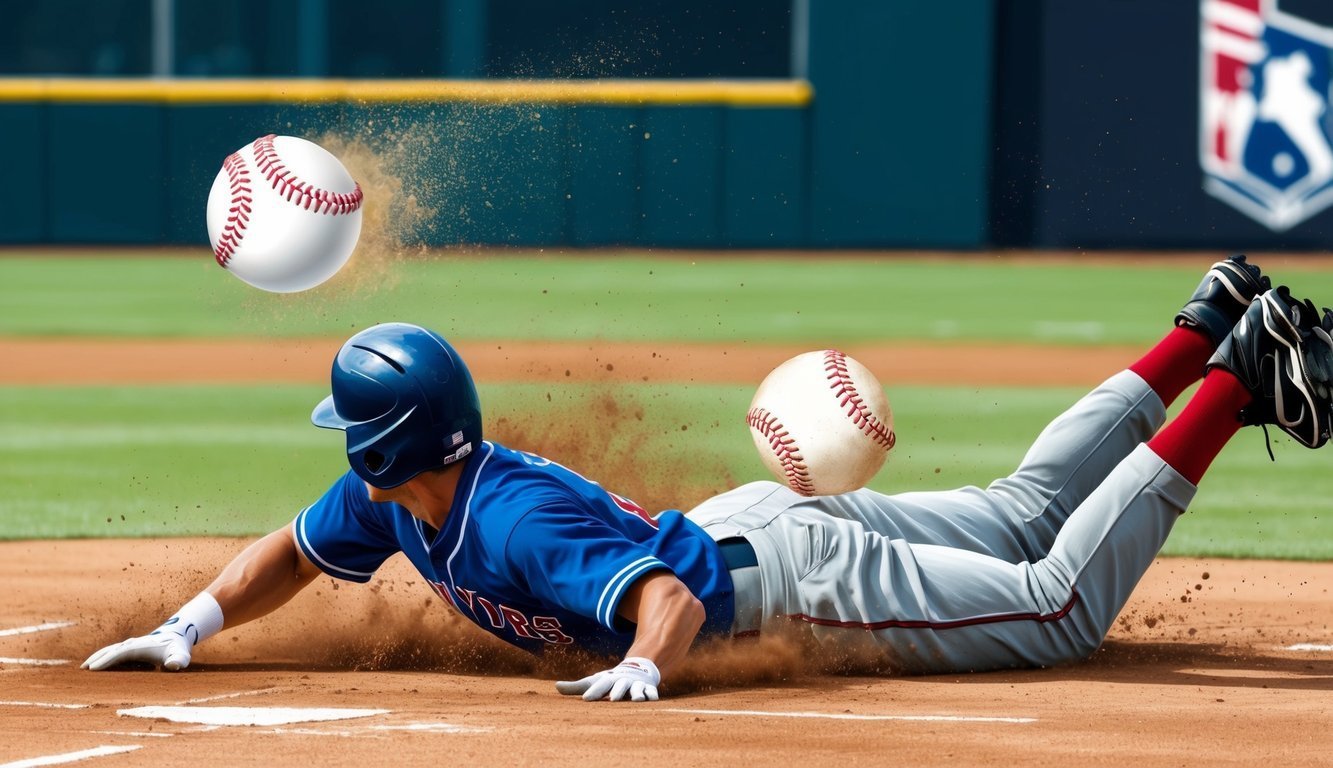Baseball takes a physical toll on players, from Little League to the World Series.
Professional athletes in Major League Baseball face a constant risk of injuries that can sideline them for days, weeks, or even entire seasons. The most common baseball injuries include rotator cuff tears, elbow strains, and oblique muscle strains.
These injuries often land players on the injured list, impacting team performance and playoff chances.
Pitchers are particularly susceptible to arm and shoulder problems due to the repetitive stress of throwing.
Position players aren’t immune either, with diving catches and baserunning collisions posing injury risks.
Understanding the top baseball injuries helps fans appreciate the challenges players face.
It also highlights the importance of proper training, conditioning, and medical care in keeping athletes on the field.
Additionally, awareness of these injuries can foster empathy among fans, as they recognize the physical toll the sport can take on its stars.
Moreover, the impact of social issues on baseball, such as the pressures of performance and the mental health challenges athletes encounter, cannot be overlooked.
By understanding both the physical and social challenges players face, fans can support their heroes beyond the game.
Common Baseball Injuries
Baseball players face various injury risks due to the sport’s repetitive motions and high-impact movements.
These injuries can affect different parts of the body, often sidelining players for extended periods.
Shoulder and Elbow Injuries
Pitchers often suffer from rotator cuff tears.
These injuries involve damage to the muscles and tendons that stabilize the shoulder joint.
Symptoms include pain, weakness, and reduced range of motion.
Meanwhile, Tommy John surgery addresses ulnar collateral ligament (UCL) damage in the elbow.
This procedure is common for pitchers who experience pain and instability in their throwing arm.
Labral tears affect the cartilage surrounding the shoulder socket.
Players may feel a “catching” sensation and instability in the joint.
Rest, physical therapy, and sometimes surgery are necessary for recovery.
Knee and Leg Injuries
ACL tears can occur during sudden stops or direction changes.
This injury to the knee’s anterior cruciate ligament often requires surgery and extensive rehabilitation.
On the other hand, hamstring strains are frequent in baseball, especially during sprinting.
These injuries range from mild to severe and can sideline players for weeks or even months.
Lastly, patellar tendinitis, also known as “jumper’s knee,” causes pain in the front of the knee.
It’s common in catchers due to their frequent squatting and rising motions.
Back and Oblique Injuries
Lower back strains often result from the twisting motions involved in batting and pitching.
These injuries can be acute or develop over time due to repetitive stress.
Meanwhile, oblique strains affect the muscles on the sides of the abdomen.
They’re particularly common in batters and can significantly impair a player’s ability to swing effectively.
Lastly, disc herniation in the spine can occur from the repetitive bending and twisting in baseball.
This injury may cause severe pain and require extended recovery time.
Injury Prevention and Management
Proper techniques and smart training habits can significantly reduce the risk of baseball injuries.
Focusing on key areas like pitching mechanics and overall conditioning helps players stay healthy and perform at their best.
Pitching Mechanics and Workload
Good pitching mechanics are crucial for preventing arm injuries.
Pitchers should focus on using their whole body, not just their arm, to generate power.
Proper follow-through and a balanced finish position help distribute stress evenly.
Monitoring pitch counts is essential, especially for young players.
Experts recommend limiting pitches based on age:
- Ages 7-8: 50 pitches per game
- Ages 9-10: 75 pitches per game
- Ages 11-12: 85 pitches per game
Rest between outings is just as important as pitch counts.
Pitchers should take at least 1 day off for every 20 pitches thrown in a game.
Conditioning and Recovery Strategies
A well-rounded strength and flexibility program helps prevent injuries across all positions.
Core exercises, leg workouts, and shoulder strengthening routines are particularly beneficial.
Players should incorporate dynamic warm-ups before games and practices.
This might include:
- Light jogging
- Arm circles
- Leg swings
- Torso twists
Proper hydration and nutrition support recovery.
Players should drink water throughout the day and eat balanced meals with plenty of protein.
Ice therapy after pitching can reduce inflammation.
Applying ice to the shoulder and elbow for 15-20 minutes helps kickstart the recovery process.
Lastly, regular stretching improves flexibility and reduces injury risk.
Focus on major muscle groups used in baseball, like the shoulders, back, and legs.
Notable Injuries and Comebacks

Baseball has seen its share of career-altering injuries, but also inspiring comebacks.
Players have overcome seemingly insurmountable obstacles to return to the diamond and excel.
Tommy John Surgery Success Stories
Tommy John surgery has saved countless pitching careers.
Jacob deGrom underwent the procedure in 2022 and made a successful return in 2023, regaining his elite form.
Max Scherzer bounced back from the surgery early in his career to become one of the game’s top aces.
John Smoltz had the operation at age 33 and came back to be an effective closer before returning to starting.
Meanwhile, Kerry Wood’s promising career was derailed by elbow issues, but Tommy John surgery allowed him to pitch for over a decade more.
Rehabilitation Highlights
Fernando Tatis Jr. faced a challenging road back after shoulder and wrist injuries.
Through intense rehab, he returned to All-Star form in 2024.
Slugger Albert Pujols overcame plantar fasciitis to continue his march towards 700 home runs.
Buster Posey’s gruesome leg injury in 2011 threatened his career.
After months of rehab, he came back to win NL MVP in 2012.
Lastly, Yu Darvish battled through years of arm troubles before re-emerging as an ace starter following thorough rehabilitation.
Impact of Injuries on Teams and Seasons

Injuries can dramatically alter a team’s fortunes and shape the course of a season.
They test roster depth, challenge team strategies, and often determine playoff outcomes.
Playoff Roster Implications
Injuries during crucial moments can derail a team’s postseason hopes.
The Philadelphia Phillies faced this challenge in recent years when key players were sidelined.
Teams must carefully manage their 15-day injured list to ensure players are ready for high-stakes games.
Playoff rosters become a puzzle, with managers weighing the risks of playing recovering stars against using healthy backups.
This decision-making process is especially critical in short series like the ALDS, where a single game can make or break a team’s World Series dreams.
Team Strategies in Coping with Injuries
Major League Baseball teams employ various strategies to mitigate the impact of injuries.
The Milwaukee Brewers, known for their pitching depth, often rotate starters to prevent overuse and reduce injury risk.
Some teams, like the Miami Marlins, focus on developing a strong farm system to provide quality replacements when injuries strike.
Others, such as the Texas Rangers, might pursue trades to fill gaps left by injured players.
Flexibility in player positioning has become crucial.
Teams train utility players who can cover multiple positions, providing valuable options when the injury bug bites.
This adaptability can be the difference between a playoff berth and an early offseason.
Injuries and Player Careers

Baseball injuries can significantly impact a player’s career trajectory and earning potential.
Managing health and recovering from setbacks are crucial aspects of a professional athlete’s journey.
Managing Player Health for Longevity
Teams invest heavily in injury prevention programs.
Strength training, proper nutrition, and regular health screenings help players stay on the field.
Advanced sports medicine techniques aid in faster recovery times.
Tommy John surgery, once career-ending, now allows pitchers to return to the mound after rehabilitation.
Rest and rotation strategies prevent overuse injuries.
Teams carefully monitor pitch counts and innings pitched for their valuable arms.
Players work with specialized trainers to maintain flexibility and core strength.
This focus helps reduce the risk of common baseball injuries like oblique strains and back issues.
The Effect of Injuries on Player Contracts
Long-term injuries can affect a player’s market value.
Teams may hesitate to offer lucrative deals to athletes who often get injured.
Performance clauses in contracts often tie bonuses to games played or innings pitched.
Players on the IL (Injured List) may miss out on these incentives.
Some contracts include injury protection for teams.
These clauses can reduce a player’s salary if they spend significant time on the IL.
Free agents with recent injury history might receive shorter-term deals.
Teams prefer to minimize risk when signing players coming off major surgeries.
Star players who maintain health often secure larger, longer contracts.
Their ability to stay on the field consistently increases their value to teams.
